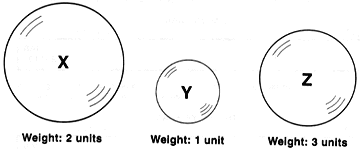|
Contributed by: Kentucky Department of Education (KDE)
TASK: Rising Waters
Student Name:
School Name:
GENERAL INSTRUCTIONS
Write your name and school name on the lines above. Do not open
this test until the directions tell you to do so.
The purpose of this task is to figure out why different floating
balls put carefully into a pitcher of water make the water rise
different amounts. You will have a total of 45 minutes to complete
this task. You may use up to 30 minutes to complete the group portion
of the task.
Your group should have the following materials:
- six balls
- pitcher of water
- tape measure
- balance scale
- empty measuring pitcher
- bag of hex nuts
- string
- rulers
- pencils
GROUP ACTIVITY
Joe and Ann were floating some balls in water. They noticed that,
even though the balls floated, every ball didn't float in the same
way. Then they got a pitcher with measurements on the side. They
put water into the pitcher and carefully placed one ball at a time
into the pitcher. They saw that some of the balls made the water
rise in the pitcher more than others.
Your group will help Joe and Ann find out why some balls make the
water in the pitcher rise more than others.
You have six balls of different sizes made out of different materials.
Your job is to find out how the weight and size of
each ball affects how much the water in the pitcher rises when the
ball floats.
Please continue the group work on page 2.
- Figure out how to rank the balls by size from smallest to biggest.
Each member of the group should enter the letters of the balls
in order below.
RANK BY SIZE
|
Smallest |
|
|
|
|
Biggest |
BALL
LETTER |
|
|
|
|
|
|
- Figure out how to rank the balls by weight from lightest to
heaviest. Each member of the group should enter the letters of
the balls in order below.
RANK BY WEIGHT
|
Lightest |
|
|
|
|
Heaviest |
BALL
LETTER |
|
|
|
|
|
|
- Put 500 milliliters of water into the liter pitcher. Then carefully
float each ball, one at a time in the water. Figure out how much
each ball makes the water rise. Record the amount the water
rises below. After taking each ball out of the pitcher, check
the water level to be sure it is still at 500 ml before you try
the next ball.
| Ball A ___ ml |
Ball C ___ ml |
Ball E ___ ml |
| Ball B ___ ml |
Ball D ___ ml |
Ball F ___ ml |
- Rank the balls by how much they made the water rise in the pitcher.
Enter the letters of the balls in order below.
|
Water rose
Least |
|
|
|
|
Water rose
Most |
BALL
LETTER |
|
|
|
|
|
|
- Now, as a group, discuss what you could tell Joe and Ann about
why certain balls make the water rise higher than do other balls.
When you finish the work on this page, someone should tell the
person in charge that your group has finished its work. Then complete
the rest of the test yourself, without talking.
INDIVIDUAL ACTIVITY
Use the information you listed on page 2 to help you answer the
rest of the questions.
- What did you do to rank the balls by size? What tools, if any,
did you use?
- What did you do to rank the balls by weight? What tools, if
any, did you use?
- Why do you think that the water rose more for some balls than
for others? Explain why you think so.
Use these pictures of balls X, Y, and Z to answer questions
9 and 10.

- Rank the balls X, Y, and Z by how much they would make water
rise in a pitcher.
|
Water would rise Least |
|
Water would rise Most |
| BALL LETTER |
|
|
|
- Why do you think that the way you ranked the balls in question
9 is correct?
|


